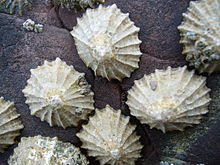Patellidae
| Patellidae | |
|---|---|

| |
| A group of live Patella vulgata on an intertidal rock | |
| Scientific classification | |
| Domain: | Eukaryota |
| Kingdom: | Animalia |
| Phylum: | Mollusca |
| Class: | Gastropoda |
| Subclass: | Patellogastropoda |
| Superfamily: | Patelloidea |
| Family: | Patellidae Rafinesque, 1815 |
| Genera | |
|
4 extant genera (see text) | |
Patellidae is a taxonomic family of true limpets, marine gastropod molluscs in the superfamily Patelloidea.[1] (The superfamily Patelloidea should not be confused with the similar-sounding genus of true limpets Patelloida which is in the family Lottiidae within the superfamily Lottioidea, also part of the Patellogastropoda.)
The largest known limpet in the world is Scutellastra mexicana that can reach 35.5 cm (14.0 in) in length.[2]
Taxonomy[edit]
A cladogram showing phylogenic relations of Patellogastropoda based on molecular phylogeny research by Nakano & Ozawa (2007):[3]
| Patellogastropoda |
| ||||||||||||||||||
Genera[edit]
There are four extant genera in the family Patellidae:[1]
- Cymbula H. & A. Adams, 1854
- Helcion Montfort, 1810
- Patella Linnaeus, 1758
- Scutellastra H. Adams & A. Adams, 1854
There are two exclusively fossil genera:[1]
Synonyms[edit]
Synonyms include the following:[1]
- Ansates G.B. Sowerby II [ex Klein], 1839: synonym of Patella Linnaeus, 1758
- Laevipatella Pallary, 1920: synonym of Cymbula H. Adams & A. Adams, 1854
- Patellanax Iredale, 1924: synonym of Scutellastra H. Adams & A. Adams, 1854 (junior synonym)
- Patellidea Thiele, 1891: synonym of Scutellastra H. Adams & A. Adams, 1854
- Patellona Thiele, 1891: synonym of Cymbula H. Adams & A. Adams, 1854
- Patina Gray, 1847: synonym of Patella Linnaeus, 1758
- Patinastra Thiele, 1891: synonym of Helcion Montfort, 1810
- Penepatella Iredale, 1929: synonym of Scutellastra H. Adams & A. Adams, 1854 (junior synonym)
Human uses[edit]
Some limpet species in this family are used as a food source in various countries.[2]
A study of Patella caerulea found that this limpet reduced the cover of algae and barnacles on steel panels suspended in sea water in a commercial port, suggesting that the limpet could be used to inhibit fouling of ship hulls.[4]
See also[edit]
References[edit]
- ^ a b c d Bieler R, Bouchet P, Gofas S, Marshall B, Rosenberg G, La Perna R, Neubauer TA, Sartori AF, Schneider S, Vos C, ter Poorten JJ, Taylor J, Dijkstra H, Finn J, Bank R, Neubert E, Moretzsohn F, Faber M, Houart R, Picton B, Garcia-Alvarez O, eds. (2023). "Patellidae Rafinesque, 1815". MolluscaBase. World Register of Marine Species. Retrieved 3 July 2023.
- ^ a b Carballo, José Luis; Bautista‐Guerrero, Eric; Benjamín, Yáñez; Carballo, Luis Rodrigo & García‐Gómez, José Carlos (2023). "Population status of the world's largest limpet, Scutellastra mexicana (Mollusca: Patellidae), on María Madre Island, Mexico: Possible last bastion of a species facing global extinction". Aquatic Conservation: Marine and Freshwater Ecosystems. doi:10.1002/aqc.3978.
- ^ Nakano, Tomoyuki; Ozawa, Tomowo (2007). "Worldwide phylogeography of limpets of the order Patellogastropoda: molecular, morphological and palaeontological evidence". Journal of Molluscan Studies. 73 (1): 79–99. doi:10.1093/mollus/eym001.
- ^ Safriel U. N. & Erez N. 1987. Effect of limpets on the fouling of ships in the Mediterranean. Marine Biology, 95(4): 531-537. doi:10.1007/BF00393096
- Nakano T. & Sasaki T. (2011) Recent advances in molecular phylogeny, systematics and evolution of patellogastropod limpets. Journal of Molluscan Studies 77: 203–217.
External links[edit]
- Rafinesque, C. S. (1815). Analyse de la nature ou Tableau de l'univers et des corps organisés. [Book]. 1-224, (self-published) Palermo
- Bouchet, P. & Rocroi, J.-P. (2005). Classification and nomenclator of gastropod families. Malacologia. 47 (1-2): 1-397
- Ridgeway, S.A., Reid, D.G., Taylor, J.D., Branch, G.M. & Hodgson, A.N., 1998. A cladistic phylogeny of the family Patellidae (Mollusca: Gastropoda). Philosophical transactions of the Royal Society of London, Series B, 353(1375), 1645-1671
